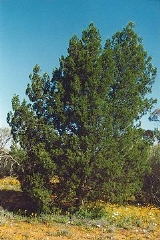
Callitris columellaris
Encyclopedia
Callitris columellaris is a species of coniferous tree
in the family Cupressaceae
(cypress family), native to most of Australia
. Common names include White Cypress-pine, Murray River Cypress-pine, and Northern Cypress-pine.
It is a small evergreen
tree
, 4–12 m (rarely to 20 m) high, with a trunk up to 50 cm diameter. The leaves
are scale-like, 2-6 mm long and 0.5 mm broad, arranged in decussate whorls of three on very slender shoots 0.7-1 mm diameter. The cones
are globose, 1-2 cm diameter, with six triangular scales, which open at maturity to release the seeds.
Some authors (e.g. Thompson & Johnson 1986, followed by the Flora of Australia Online) divide it into three species (or occasionally as varieties
), based largely on the foliage colour, with green plants predominating on the east coast of Australia, and glaucous plants in the interior, and on cone size, with on average marginally smaller cones in tropical areas (north of 22°S). However, others (e.g. Blake 1959, Farjon 2005) point out that both the foliage colour and cone size is very variable, even from tree to tree in local populations, and maintain that it is impossible to distinguish three taxa within the species. When split into three species, the following names apply:
Tree
A tree is a perennial woody plant. It is most often defined as a woody plant that has many secondary branches supported clear of the ground on a single main stem or trunk with clear apical dominance. A minimum height specification at maturity is cited by some authors, varying from 3 m to...
in the family Cupressaceae
Cupressaceae
The Cupressaceae or cypress family is a conifer family with worldwide distribution. The family includes 27 to 30 genera , which include the junipers and redwoods, with about 130-140 species in total. They are monoecious, subdioecious or dioecious trees and shrubs from 1-116 m tall...
(cypress family), native to most of Australia
Australia
Australia , officially the Commonwealth of Australia, is a country in the Southern Hemisphere comprising the mainland of the Australian continent, the island of Tasmania, and numerous smaller islands in the Indian and Pacific Oceans. It is the world's sixth-largest country by total area...
. Common names include White Cypress-pine, Murray River Cypress-pine, and Northern Cypress-pine.
It is a small evergreen
Evergreen
In botany, an evergreen plant is a plant that has leaves in all seasons. This contrasts with deciduous plants, which completely lose their foliage during the winter or dry season.There are many different kinds of evergreen plants, both trees and shrubs...
tree
Tree
A tree is a perennial woody plant. It is most often defined as a woody plant that has many secondary branches supported clear of the ground on a single main stem or trunk with clear apical dominance. A minimum height specification at maturity is cited by some authors, varying from 3 m to...
, 4–12 m (rarely to 20 m) high, with a trunk up to 50 cm diameter. The leaves
Leaf
A leaf is an organ of a vascular plant, as defined in botanical terms, and in particular in plant morphology. Foliage is a mass noun that refers to leaves as a feature of plants....
are scale-like, 2-6 mm long and 0.5 mm broad, arranged in decussate whorls of three on very slender shoots 0.7-1 mm diameter. The cones
Conifer cone
A cone is an organ on plants in the division Pinophyta that contains the reproductive structures. The familiar woody cone is the female cone, which produces seeds. The male cones, which produce pollen, are usually herbaceous and much less conspicuous even at full maturity...
are globose, 1-2 cm diameter, with six triangular scales, which open at maturity to release the seeds.
Some authors (e.g. Thompson & Johnson 1986, followed by the Flora of Australia Online) divide it into three species (or occasionally as varieties
Variety (biology)
In botanical nomenclature, variety is a taxonomic rank below that of species: as such, it gets a three-part infraspecific name....
), based largely on the foliage colour, with green plants predominating on the east coast of Australia, and glaucous plants in the interior, and on cone size, with on average marginally smaller cones in tropical areas (north of 22°S). However, others (e.g. Blake 1959, Farjon 2005) point out that both the foliage colour and cone size is very variable, even from tree to tree in local populations, and maintain that it is impossible to distinguish three taxa within the species. When split into three species, the following names apply:
- Callitris columellaris F.Muell. sensu stricto – coastal northeast New South WalesNew South WalesNew South Wales is a state of :Australia, located in the east of the country. It is bordered by Queensland, Victoria and South Australia to the north, south and west respectively. To the east, the state is bordered by the Tasman Sea, which forms part of the Pacific Ocean. New South Wales...
, southeast QueenslandQueenslandQueensland is a state of Australia, occupying the north-eastern section of the mainland continent. It is bordered by the Northern Territory, South Australia and New South Wales to the west, south-west and south respectively. To the east, Queensland is bordered by the Coral Sea and Pacific Ocean...
. - Callitris glaucophylla Joy Thomps. & L.A.S.Johnson (syn. C. columellaris var. campestris Silba; C. glauca nom. inval.; C. hugelii nom. inval.) – throughout most of the southern half of Australia.
- Callitris intratropica R.T.Baker & H.G.Smith (syn. C. columellaris var. intratropica Silba) – northern Queensland, northern Northern TerritoryNorthern TerritoryThe Northern Territory is a federal territory of Australia, occupying much of the centre of the mainland continent, as well as the central northern regions...
, northern Western AustraliaWestern AustraliaWestern Australia is a state of Australia, occupying the entire western third of the Australian continent. It is bounded by the Indian Ocean to the north and west, the Great Australian Bight and Indian Ocean to the south, the Northern Territory to the north-east and South Australia to the south-east...
.

